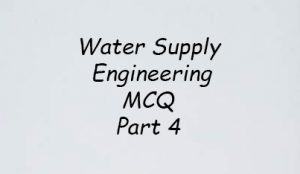Water Supply Engineering MCQ Part 4- Environmental Engineering MCQ
Water Supply Engineering MCQ Part 4 Questions

Question No. 1
Property of earth to allow water to pass through it, is known as
(A) Perviousness
(B) Porosity
(C) Permeability
(D) Transmissibility
Question No. 2
Plain chlorination is used for water
(A) Obtained from clear lakes
(B) Consumed during emergencies
(C) Supplies to armies during war
(D) All the above
Question No. 3
A city supply includes
(A) Domestic water demand
(B) Industrial and commercial water demands
(C) Demand for public uses and fire
(D) All the above
Question No. 4
The pH value of water is kept slightly less than 7 so that hydrochloride ions may combine with ammonia ions to form
(A) Mono-chloramine (NHCl)
(B) Di-chloramine (NH2Cl)
(C) Nitrogen tri-chloramine (NCl3)
(D) All the above
Question No. 5
Pick up the correct statement from the following:
(A) Copper pipes are highly resistant to acidic and alkaline water
(B) Wrought iron pipes are lighter than cast iron pipes
(C) Wrought iron pipes corrode quickly and are less durable
(D) All the above
Question No. 6
Pick up the correct statement from the following:
(A) A hydrograph is a plot of discharge versus time
(B) A mass curve is a plot of accumulated flow versus time
(C) The mass curve continuously rises
(D) All the above
Question No. 7
Rapid gravity filters
(A) Were developed by G.W. Fuller
(B) Make use of coarser sand with effective size as 0.5 mm
(C) Yield as high as 30 times the yield of slow sand filters
(D) All the above
Question No. 8
Distribution mains of any water supply, is normally designed for its average daily requirement
(A) 100 %
(B) 150 %
(C) 200 %
(D) 225 %
Question No. 9
Maximum threshold number permitted for indicating the odour of public water supplies, is
(A) 1
(B) 2
(C) 3
(D) 4
Question No. 10
The rate of silting in a reservoir
(A) Is less in the beginning
(B) Remains constant throughout
(C) Is more in the beginning
(D) is more in the beginning and reduces in the end
Water Supply Engineering MCQ Part 4 Answers
Question No 1: A
Question No 2: D
Question No 3: D
Question No 4: D
Question No 5: D
Question No 6: D
Question No 7: D
Question No 8: D
Question No 9: C
Question No 10: D
Read More: Water Supply Engineering MCQ Part 1
Read More: Water Supply Engineering MCQ Part 2
Read More: Water Supply Engineering MCQ Part 3